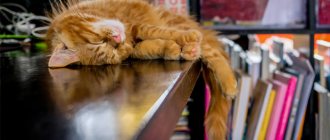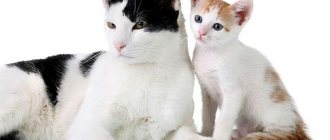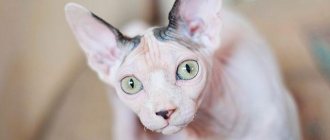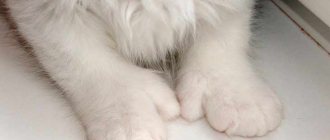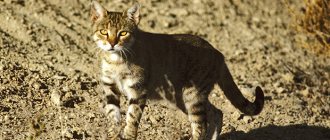The average lifespan of Persian cats is 17 years. These cats are known throughout the world and are loved by many people for their unusual appearance with a flattened muzzle. However, it is she who brings a lot of problems into the life of a pet. To avoid them and prolong the life of the animal, the owner should follow simple rules.
Types of Persian cats
There are 3 main types of Persian cats.
Representatives of each of them are quite strong, but the classic Persian shows the maximum life expectancy.
- Classic type. Externally, the animal is quite similar in face to ordinary cats. His nose is located below his eyes.
- Modern type. The difference from other breeds is pronounced. The lower eyelid is level with the nose.
- Extreme (American) type. The nose is at the height of the inner corners of the eyes, which gives the effect of a snub nose.
Important! An exotic cat, which has short hair and a muzzle similar to Persians, is their close relative, but of a different breed.
Life on the street
The average life expectancy of yard or walking cats is significantly less than that of their domestic relatives. Their age rarely exceeds 10 years and this is influenced by several factors:
- weather;
- lack of food, hunger;
- increased risk of various diseases;
- the likelihood of injury or poisoning;
- stress.
The life of a pet directly depends on its owner. Therefore, answering the question of how long domestic cats live after castration is only possible in general terms. Castration alone is not enough to prolong life. It is important to constantly pay attention to your pet and feed him quality food.
Experts recommend neutering your pet at the age of 6-8 months. This is considered the optimal time for the procedure, since the cat’s genitals are already developed. However, he was not yet interested in representatives of the opposite sex.
What affects the lifespan of a Persian
In addition to genetics, a pet’s life expectancy is also influenced by proper nutrition, sufficient physical activity, regular hygiene, castration or sterilization and timely vaccination.
The peculiarity of Persian cats is their long hair and short nose. Because of them, if not properly cared for, the animal begins to get sick.
The special structure of the upper parts of the respiratory system does not allow the cat’s body to fully resist viral infections. Because of this, the Persian is practically defenseless before them.
Vaccination against cat flu is mandatory annually. This is an important measure to prevent a dangerous disease. Long hair easily becomes tangled, which dramatically worsens the cat's condition.
Be sure to read:
Siberian cat: characteristics of the Russian forest cat breed, what it looks like, content
If you don’t have time to brush your Persian, you shouldn’t get a cat.
Sterilization and castration of animals that are not allowed to breed is mandatory. This allows you to avoid regular hormonal surges that undermine the health of Persian cats.
This reduces the risk of developing cancer, and completely eliminates some of them. When buying a kitten, you need to choose the strongest and most active one.
An animal that is born healthy has a better chance of living as long as possible.
How long do castrated cats live?
How many years do castrated cats live is of interest to everyone who is planning to castrate their pet. And why all? Those who are not castrated have behavior that is, to put it mildly, antisocial: screaming, desire to find the cat, marked territory. The latter drives almost everyone crazy: you, since the whole house, car, plot, if you have one, and the neighbors, since the four-legged furry manages to visit them on the balcony or in the garden to do the same thing, what is he doing with you? The scary thing is that in this condition, cats go far from home, fight with other males, can get hurt in unfamiliar terrain, and often leads to long-term treatment consequences or even the death of the animal.
We recommend reading: Pancreas Inflamed in Dog Symptoms
What is the life expectancy of neutered cats?
In principle, neutered pets live longer than non-neutered ones. This is, of course, a plus. These animals cannot become infected with various diseases through sexual contact, do not get injured during fights and do not wander kilometers from home.
But there are also disadvantages. Neutered cats have hormonal imbalances. Simply - the production of hormones decreases. And this causes the development of obesity, both in cats and in sterilized cats. Therefore, they need to be fed only balanced food, which helps burn excess fat. More suitable foods are those containing birch leaf, bean leaves, green tea, plantain, oregano and other herbal extracts.
In addition to obesity, naturalized animals experience salt retention and may develop urological syndrome or urolithiasis. These diseases greatly torment the animal and exhaust its owner. Therefore, it is better not to let the kitten loose from the beginning, accustoming it only to healthy food.
In many ways, the life expectancy of a castrato is influenced by overly caring owners. How long do you think British neutered cats live? Believe me, for a very long time. They have genetically good health, a powerful and strong body, but they are not eaters by nature. And therefore there is no point in disbanding them. These cats lead an active life, and they know very well how much food they need to recuperate.
On average, British people live 15 years, castrated people live a little longer, and they do not develop cancer. But this disease often affects those who are not naturalized.
Owners of Persian cats are no less interested in how long their castrated brothers live. With good care, your baby will delight you for 18 years and even more.
In principle, neutered pets live longer than non-neutered ones. This is, of course, a plus. These animals cannot become infected with various diseases through sexual contact, do not get injured during fights and do not wander kilometers from home.
average life expectancy
On average, according to the description of the breed, a Persian cat with proper care and satisfactory initial health lives 13-15 years.
On average, a Persian cat lives 13-15 years if properly cared for.
In practice, if all conditions are met, if the cat does not experience stress, it will live up to 18-20 years.
Interesting! The oldest Persian cat is documented to have been 38 years old at the time of death.
Origin
Before answering the question, let's look at the history and varieties of Persian cats. The Persian cat is considered one of the first breeds domesticated by humans. But experts have not agreed on exactly where and how the furry “Persian” was domesticated. The reason lies in the pet’s luxurious long fur.
There is an opinion that the Persian cat first appeared in Central Asia, but the hot climate does not fit with the animal’s long hair. Experts put forward several versions of the origin of the Persian cat:
- Patriotic. According to one version, the animal was brought to Ancient Persia by sailors from Siberia. This version answers the question about the origin of long hair, but, unfortunately, experts have not found any evidence of the appearance of the ancestors of the modern Persian cat in Russia.
- Love. Another version says that an ordinary purr was carried away by a wild steppe manul. As a result of feline relationships, the Persian cat appeared.
An alternative version suggests that the connection occurred between an ordinary cat and the Angora breed.
One way or another, in the 17th century, an Italian traveler, while in Asia, noticed elegant long-haired beauties.
ATTENTION! Unable to resist the beauty of the animals, he took several pets with him to Europe. After some time, the breed appeared in France, where it immediately became popular among the local aristocracy.
Of course, nowadays, thanks to the efforts of breeders, there are many different types of Persian purrs. More than 100 breeds are distinguished by coat color alone. Let's look at coloring in a little more detail:
- White. You can say the classic look of pets. The eyes are blue or orange.
- Black. Black long-haired beauties. White spots on the body are allowed. The eyes are orange.
- Color point. Persian cats come in a variety of colors. Ears, paws, and nose may be black. Blue eyes.
- Tortoiseshell. The wool is colored in chocolate, cream, blue and black shades. Copper colored eyes.
- Ginger. Solid orange coat color. Copper colored eyes.
Another distinctive feature of the breed is the nose. Persian cats have a small but wide tail. Depending on the type of nose, several breeds are distinguished:
- English – the nose is straight, located just below the eyes;
- European - snub nose, located along the upper border at the level of the lower eyelids;
- extreme – snub nose, located at the level of the upper eyelids.
At first, there was another breed of Persian cats - peak face. But their noses were turned up so high that they created health problems. The breed experienced problems with nutrition, breathing, and excessive tearing.
It was the extreme Persian, thanks to the efforts of the breeders, who became the receiver of the peak face. The specialist managed to solve the health problems, although we will crossbreed.
Diseases of Persian cats, prevention
Eye inflammation is a common problem for Persians. Usually the disorder is caused by conjunctivitis or infectious lesions of the eyeballs.
Prevention of inflammation - proper eye hygiene. If purulent discharge from the eyes appears, you should immediately consult a veterinarian.
Gingivitis threatens the animal with tooth loss. Inflammation of the gums develops due to the cat’s poor diet and the presence of tartar.
Inflammation of the eyes is a common problem for Persians.
Some animals are affected by the following pathologies:
- retinal atrophy;
- viral rhinotracheitis;
- polycystic kidney disease;
- ulcerative keratitis.
The best prevention of diseases is proper maintenance of the cat and regular, once every six months, visits to the veterinarian for a preventive examination.
Identifying diseases at an early stage significantly increases the likelihood that your pet can be cured completely.
Important! It is unacceptable to use medications for therapy that are not prescribed by a veterinarian.
Advantages and disadvantages of the procedure
After castration, the cat becomes calmer and more balanced. He will not get into a fight and will not leave the house for a long time. The possibility of contracting sexually transmitted diseases is excluded.
The main disadvantage is the pet's subsequent tendency to overeat. This often leads to obesity. In castrated cats, the production of hormones is disrupted, and obesity can occur due to hormonal background.
If a neutered pet eats natural food, it increases the risk of urolithiasis and other kidney pathologies. For this reason, it is recommended to prepare a menu for your pet in advance.
How to extend the life of a Persian: care and maintenance
Proper care of your pet helps to prolong the life of a Persian. For elite animals, it is much more difficult, since breeders sacrifice their health for the sake of appearance.
Be sure to read:
Burmese sacred cat: appearance, character, price, care and maintenance of the breed
Grooming
For combing cats, choose steel combs with long teeth rounded at the ends. You should not use a powder brush.
This is a tool for professional grooming of Persians, which is used in the process of preparing the animal for exhibitions.
Steel combs are preferred for grooming cats.
Only the paws and muzzle are treated with it. Combing is carried out daily. At the time of shedding, it is necessary 2 times a day. Cats are taught to brush from an early age.
Bathing
Bathing your Persian is a mandatory procedure. I need it once a month. When shedding, it is better to bathe your pet more often to avoid the formation of mats.
Use special shampoo for long-haired cats for washing. Persians are accustomed to water from childhood.
After washing, dry the cat first with a terry towel, and then dry the fur with a hairdryer. You should not leave your Persian to dry naturally due to the risk of tangles forming. Getting used to a hairdryer, like bathing, begins in childhood.
Hygiene of the nose, eyes and ears
Hygienic procedures for the eyes, ears and nose are a mandatory step in caring for an animal.
In their absence, the pet will quickly begin to get sick. The ears are wiped once a week with a cotton swab dipped in cat ear care lotion.
Hygienic procedures for the eyes, ears and nose are a mandatory step in caring for an animal.
The eyes are wiped with a soft cloth moistened with a special solution (the product is sold in a pet store). The procedure is carried out at least once every 2 days, and it is advisable to do it daily.
Wipe the nose once a week with a clean cloth moistened with a water infusion of calendula. If there is heavy discharge from the nose, then cleaning is carried out once a day, using a product prescribed by a veterinarian.
Feeding
The animal's food is selected according to its age. If ready-made food is given, then choose one intended for young, adult or aging animals.
Economy class meals cannot be used.
With natural feeding, 40% of the diet should be meat, 20% milk proteins and eggs, 15% offal, 15% vegetable fiber and 5% lean sea fish. Natural feeding is a priority for any cat.
Be sure to read:
The Ragamuffin is a breed of domestic cat derived from crossing the Ragdoll.
Persian diet
The better a Persian cat eats, the better it looks. Feed her with professional food from James, First Choice, Eagle Pack, Royal Canin, Askana, and Hills brands. Dry food is low in liquid, so add broth to it. With proper feeding, the purebred miracle will be healthy, happy and in gratitude will give you affection and love. Add the following foods to your daily diet:
- Boiled lean meat without bones.
- Boiled or steamed sea fish without bones.
- Vegetables are raw, steamed or boiled.
- Low-fat fermented milk products. Milk can be given to kittens up to four months of age; in adult cats it can cause stomach upset. Give calcium-rich curd products. Hard cheese no more than once every 3 days.
- Greenery.
- Fresh water.
- Taurine, minerals, vitamins - as recommended by a veterinarian.
how many years do cats live?
The oldest cat was 33 years old. A resident of the British county of Essex says that her favorite yard cat is currently the oldest in the world and should take its place in the Guinness Book of Records. According to the owner of the long-lived cat, Jean Stone from the city of Jaywick, her pet named Whiskey is now 33 years old, or 231 by human standards. “I found it on March 17, 1971 in a trash bin. The kitten was very tiny - its eyes had not even opened yet, and it was clear from everything that it had just been born. I couldn’t even imagine that he would live so long, especially after such a terrible start to life,” says the owner. Whiskey, who no longer has his front teeth, celebrated his birthday by eating plenty of his favorite Whiskas cat food and sleeping to his heart's content.
The owner of Whiskey hopes that the name of her pet will appear in the Guinness Book of Records. True, for this it is necessary for veterinarians to confirm the age of the cat.
The oldest cat was 33 years old. A resident of the British county of Essex says that her favorite yard cat is currently the oldest in the world and should take its place in the Guinness Book of Records. According to the owner of the long-lived cat, Jean Stone from the city of Jaywick, her pet named Whiskey is now 33 years old, or 231 by human standards. “I found it on March 17, 1971 in a trash bin. The kitten was very tiny - its eyes had not even opened yet, and it was clear from everything that it had just been born. I couldn’t even imagine that he would live so long, especially after such a terrible start to life,” says the owner. Whiskey, who no longer has his front teeth, celebrated his birthday by eating plenty of his favorite Whiskas cat food and sleeping to his heart's content.
Character
Persian cats cannot live outside the house.
In general, cats of this breed are quite capricious and stubborn. At the same time, they are quite balanced. They are not prone to active aggression, and although they can stand up for themselves, more often they simply avoid contact with those they do not like. Sometimes they can take revenge.
Families often choose an owner who is loved and respected. But in the same way, many people around them can be included in the list of those whom they would prefer to avoid.
Very calm. Their voice is rarely heard. The Persians calmly and persistently ask you to pay attention to them: they sit near the owner and look intently into his face. They accompany all households from room to room. They are not afraid of children, but they do not have much love for them either.
Even though Persians are considered couch potatoes, they can be quite active when played with. Even adult cats rush after the ball with enthusiasm. They also like to catch insects that accidentally fly into the house.
Persians are curious by nature, and love to explore new and unfamiliar corners of the room.
Varieties
White Persian cat
Persian white cat
The coat is long, with a thick, very soft undercoat. The eyes are round, large, dark blue, dark orange, and may also have differently colored eyes (one eye is dark blue, the other is dark orange). The coat color is pure white, without any admixture of other colors or shades. The nose and paw pads are pink. Young animals may have black, blue, red or cream spots on the head, which disappear with age.
Persian white blue-eyed varieties may be deaf from birth. This drawback causes owners a lot of trouble. Being the owner of a deaf cat means protecting it from road accidents and other unforeseen situations, so it is better to keep such a cat at home. Deaf blue-eyed cats have a hard time making contact with other cats and, since they do not hear warning or threatening sounds, they are forced to navigate by facial expressions and gestures. If the mother suffers from deafness, then she should be placed on a hard surface so that she can feel the vibration from the sounds of her kittens. It should be noted that deaf kittens can be born from two parents with normal hearing, but it happens that kittens that are deaf from birth acquire hearing as they grow up (especially if they have a dark spot on their head at birth). Deaf cats and female cats should not be crossed together as this may result in weak offspring.
Since sunlight does not particularly harm the fur, there is no need to keep your cat indoors all the time.
FIFe and WCF recognize the white variety of the Persian cat breed, but do not recognize it as a separate breed.
Persian black
Persian black cat
The coat color is black, like a raven's wing, from the tips to the roots of the hair, without gray undercoat and individual white hairs. Brown or rusty coat color is a fault. The nose and paw pads are black or grayish-black. Eye color is smooth copper or dark orange. The coat of young animals under six months of age often has a rather poor coloration. The above-mentioned coat color defects may occur. However, this should not serve as a reason for culling young animals: coloration, as a rule, improves with age.
Sunlight has a detrimental effect on the color of the coat, so it is advisable to keep it away from windows and not to go outside with it.
This is one of the most difficult breeds to care for. A cat's fur needs to be carefully looked after every day, otherwise it becomes tangled, the undercoat falls off, and numerous tangles form. You should powder the coat daily with talcum powder or a special chalk-based powder, then comb it thoroughly with a comb or brush. In addition, regular washing is required.
In addition to fur, these cats have two significant disadvantages that arose as a result of selection. This is a defect of the nasal septum due to a flattened nose, which is why cats constantly sniffle and even snore, and constant discharge from the eyes due to blockage of the lacrimal glands.
To ensure that your cat is always well-groomed, you will need the following items: a comb with sparse and thick teeth, a brush with metal and natural bristles, a toothbrush, a grooming glove, a suede cloth, scissors with blunt ends, a rubber brush. For cats with short hair, a grooming glove, a suede cloth, and a comb are suitable.
> Notes
- List of FIFe breeds Archived October 14, 2007. (English)
- List of WCF breeds Archived May 6, 2011.
> Literature
- Bessan K. Cats: A Complete Guide // Trans. from English - M.: Niola Publishing House XXI century, 2004. - 256 p.: ill. — ISBN 5-322-00333-9 (Russian)
Relationships with other animals, children
Persian cats have an obedient, quiet, calm disposition. Adults are not hyperactive and love to spend their time basking in the warm rays of the sun. Animals of this breed are open towards others and do not like to enter into conflicts. With rare exceptions, they engage in skirmishes for leadership, often with other cats rather than with larger or smaller opponents. Persians are indifferent to birds and rodents.
This is interesting: How to Make a Scratching Post with Your Hands
Persian cats communicate willingly with children, allowing them to touch them, pull their tail and whiskers. They will never attack small, defenseless babies. In critical, stressful situations, Persians are tactful and not impulsive. They would prefer to sit in the shadows rather than engage in open confrontation.
Cats of this breed can commit mischief only by accident, having forgotten themselves in the game. They will not consciously take revenge and remember something that went wrong.
